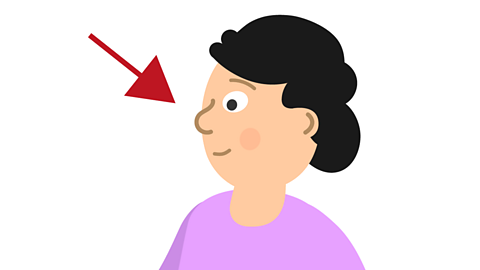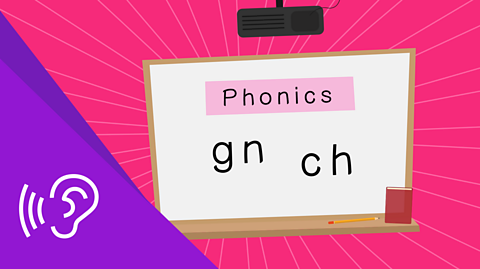French sounds
The way you say a word is called pronunciation. In French, there are some sounds that are different to English sounds.
Even if a word looks the same and means the same thing, the way that you say it isвҖҺ different in French. Watch the video below to see a few examples.
Pronouncing words in French
The sounds you make when you read French out loud are sometimes different вҖҺ to the ones youвҖҷd make in English.вҖҺ
Even if a word looks the same and means the same thing, the way you say it is вҖҺ different in French.вҖҺ
If you have a question the q is a k sound - question.вҖҺ
And ion at the end of a word is ee-on - la questionвҖҺ.
вҖҺr is pronounced rrrr. So the word for correct is pronounced corrrrrect. вҖҺ
Le train - train. It looks the same and it means the same, but вҖҰ ain is un -
le trainвҖҰвҖҺ
Aha! La musique - music. The u sound is pronounced oo - La moosique. вҖҺ
Bleu - blue. When thereвҖҷs a word with eu in it thatвҖҷs an eugh sound - bleu.
These are some of the most common sounds to get you reading French out loud!вҖҺ
Vowel sounds

In French, the vowels are a, e, i, o, u and y. Sometimes they can be written with marks above them called accents.
They do not always make the same sound as in English. When combined with other vowels or consonants, they can then make a completely different sound.
Here are some examples to help you to pronounce French words correctly. Try practising them out loud.
Vowel sounds
- a
This letter makes a similar sound to a in the English word apple. It can be written as a, Гў or Г .
Sorry, something went wrongCheck your connection, refresh the page and try again. вҖ“ the taxi
Sorry, something went wrongCheck your connection, refresh the page and try again. вҖ“ by bike
- e
The letter e at the end of a word is silent.
Sorry, something went wrongCheck your connection, refresh the page and try again. вҖ“ the swimming pool
Sorry, something went wrongCheck your connection, refresh the page and try again. вҖ“ the snow
- e
There are different ways of saying and writing e in French. The first way sounds like the sound that er makes at the end of the English word mother.
It can be written as e before one consonant or in a one syllable word.
Sorry, something went wrongCheck your connection, refresh the page and try again. вҖ“ to watch
Sorry, something went wrongCheck your connection, refresh the page and try again. вҖ“ I
Also the same sound as an вҖҳeвҖҷ in a one syllable word
- e
The second way of saying e in French sounds like the e in the English word egg.
This can be written as e before two consonants, ГЁ, ГӘ, ai, І№Г®, ei and e before a final c, l or t.
Sorry, something went wrongCheck your connection, refresh the page and try again. вҖ“ to put
Sorry, something went wrongCheck your connection, refresh the page and try again. вҖ“ a brother
Sorry, something went wrongCheck your connection, refresh the page and try again. вҖ“ to be
Sorry, something went wrongCheck your connection, refresh the page and try again. вҖ“ a house
Sorry, something went wrongCheck your connection, refresh the page and try again. вҖ“ older
Sorry, something went wrongCheck your connection, refresh the page and try again. вҖ“ the snow
Sorry, something went wrongCheck your connection, refresh the page and try again. вҖ“ with
Sorry, something went wrongCheck your connection, refresh the page and try again. вҖ“ the hotel
Sorry, something went wrongCheck your connection, refresh the page and try again. вҖ“ the chicken
Also written as ГЁ, ГӘ, ai, І№Г®, ei and e before a final c, f, l and t
- e
The third way of writing the e sound is Г©, -er, es, ez and et.
All these letter combinations make a sound which is not in English. It is a short, sharp sound which you might use to attract someone's attention. Spread your lips and make your tongue low in the mouth as you say this.
Sorry, something went wrongCheck your connection, refresh the page and try again. вҖ“ the cafe
Sorry, something went wrongCheck your connection, refresh the page and try again. вҖ“ to dance
Sorry, something went wrongCheck your connection, refresh the page and try again. вҖ“ the
Sorry, something went wrongCheck your connection, refresh the page and try again. вҖ“ enough
Sorry, something went wrongCheck your connection, refresh the page and try again. вҖ“ and
- i, Г®, y
These letters make a sound not found in English. Spread your lips in a wide grin and show your teeth to make this sound. Note the letter y also has a different sound at the start of words.
Sorry, something went wrongCheck your connection, refresh the page and try again. вҖ“ the swimming pool
Sorry, something went wrongCheck your connection, refresh the page and try again. вҖ“ the giraffe
Sorry, something went wrongCheck your connection, refresh the page and try again. вҖ“ the dinner
- o not at the end of a word
When o does not appear at the end of a word, it sounds like o in the English word hot.
Sorry, something went wrongCheck your connection, refresh the page and try again. вҖ“ orange
Sorry, something went wrongCheck your connection, refresh the page and try again. вҖ“ the ear
- o at the end of a word, Гҙ, au and eau
These letters make a sound not found in English. Make your lips into a round shape and sound as if you have had a shock.
Sorry, something went wrongCheck your connection, refresh the page and try again. вҖ“ a bike
Sorry, something went wrongCheck your connection, refresh the page and try again. вҖ“ soon
Sorry, something went wrongCheck your connection, refresh the page and try again. вҖ“ yellow
Sorry, something went wrongCheck your connection, refresh the page and try again. вҖ“ the hat
Note: although not at the end of word, o in Sorry, something went wrongCheck your connection, refresh the page and try again. makes this sound too.
- u, Г»
This letter makes a sound not found in English. Form your lips as though you are going to whistle, then say the sound for the letters ee in English.
Sorry, something went wrongCheck your connection, refresh the page and try again. вҖ“ you
Sorry, something went wrongCheck your connection, refresh the page and try again. вҖ“ a skirt
Sorry, something went wrongCheck your connection, refresh the page and try again. вҖ“ some sunglasses
Sorry, something went wrongCheck your connection, refresh the page and try again. вҖ“ August
Other vowel combinations
- eu, Е“, ІХіЬ
These letters make a sound not found in English. Imagine you have seen something unpleasant. Open your mouth a little and sound disgusted.
Sorry, something went wrongCheck your connection, refresh the page and try again. вҖ“ blue
Sorry, something went wrongCheck your connection, refresh the page and try again. вҖ“ the eye
Sorry, something went wrongCheck your connection, refresh the page and try again. вҖ“ my sister
- gu before e, i or y
Gu before these vowels make a g sound.
Sorry, something went wrongCheck your connection, refresh the page and try again. вҖ“ the guitar
- il and ill after a vowel
These letters make the English y sound.
Sorry, something went wrongCheck your connection, refresh the page and try again. вҖ“ the sun
Sorry, something went wrongCheck your connection, refresh the page and try again. вҖ“ the fog
- oi, ҙЗГ®
To make the sound for these letters, say an English w and a (as in apple) вҖ“ wa.
Sorry, something went wrongCheck your connection, refresh the page and try again. вҖ“ the fish
Sorry, something went wrongCheck your connection, refresh the page and try again. вҖ“ the car
Sorry, something went wrongCheck your connection, refresh the page and try again. вҖ“ cold
Sorry, something went wrongCheck your connection, refresh the page and try again. вҖ“ black
Sorry, something went wrongCheck your connection, refresh the page and try again. вҖ“ the box
- ou
It can be written as ou, ҙЗГ» or ҙЗГ№.
These letters make a sound not found in English. Purse your lips tightly like a chimpanzee to say this sound.
- Sorry, something went wrongCheck your connection, refresh the page and try again. вҖ“ to play
- Sorry, something went wrongCheck your connection, refresh the page and try again. вҖ“ where is?
- Sorry, something went wrongCheck your connection, refresh the page and try again. вҖ“ the stew
Nasal vowel sounds

Some vowels are called nasal vowels as you say them through your nose. They are made by allowing air to come down your nose as well as out of your mouth as you make the sound.
The below nasal sounds are all combinations of the vowels (a, e, i, o, u and y) followed by m or n. If a vowel is followed by m or n in French, then it becomes nasal and you donвҖҷt say the m or the n.
The following sounds do not exist in English.

- a, e
This can be written as am, an, em or en
Open your mouth a little and keep your tongue low in your mouth and allow the air to come through your nose and mouth.
Sorry, something went wrongCheck your connection, refresh the page and try again. вҖ“ the ham
Sorry, something went wrongCheck your connection, refresh the page and try again. вҖ“ my aunt
Sorry, something went wrongCheck your connection, refresh the page and try again. вҖ“ in spring
Sorry, something went wrongCheck your connection, refresh the page and try again. вҖ“ in winter
- i
This can be written as in, im, ain, aim, ein, eim, yn or ym.
It sounds more like the English an in ran. Put your mouth in the position to say an, then allow the air to come down your nose.
Sorry, something went wrongCheck your connection, refresh the page and try again. вҖ“ the rabbit
Sorry, something went wrongCheck your connection, refresh the page and try again. вҖ“ the train
Sorry, something went wrongCheck your connection, refresh the page and try again. вҖ“ to climb
Sorry, something went wrongCheck your connection, refresh the page and try again. вҖ“ the hunger
Sorry, something went wrongCheck your connection, refresh the page and try again. вҖ“ the painter
- ien
Say the sound for i in French, then the sound for in.
Sorry, something went wrongCheck your connection, refresh the page and try again. вҖ“ good
Sorry, something went wrongCheck your connection, refresh the page and try again. вҖ“ a dog
- o
This can be written as om or on.
Put your mouth in the position to say o as in the French word orange and then allow the air to come down your nose.
Sorry, something went wrongCheck your connection, refresh the page and try again. вҖ“ the name
Sorry, something went wrongCheck your connection, refresh the page and try again. вҖ“ the trousers
Sorry, something went wrongCheck your connection, refresh the page and try again. вҖ“ the fish
- u
This can be written as un or um.
Imagine the grunting noise people make instead of saying pardon, when they havenвҖҷt heard what you have said. Put your mouth in the position to say eu as in bleu and then allow the air to come down your nose.
Sorry, something went wrongCheck your connection, refresh the page and try again. вҖ“ a
Sorry, something went wrongCheck your connection, refresh the page and try again. вҖ“ a jumper
Sorry, something went wrongCheck your connection, refresh the page and try again. вҖ“ the perfume
More on Phonics
Find out more by working through a topic
- count2 of 2
